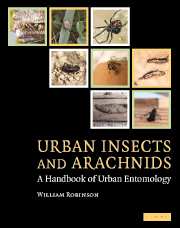2 - The urban ecosystem
Published online by Cambridge University Press: 06 August 2009
Summary
Introduction
Major ecosystems can be broadly classified as natural, agricultural, and urban. Natural ecosystems are primitive sites where the interacting plant and animal communities have not been altered by human activity. There are few, if any, of these in the world today, and a more practical definition of natural ecosystems might be undisturbed habitats that have had limited human influence, and retain a portion of their original flora and fauna. An important feature of these habitats is the populations of native plants and animals. These are the reservoir populations of many species that have adapted to agricultural and urban conditions. Agricultural and urban ecosystems are defined by their use and the degree to which their biotic and abiotic features have been altered by human activity. These ecosystems contain few of the features that characterize their natural origins; many of the features were built or brought there, or designed by humans. The degree of change and land use can be used to subdivide these two cultural ecosystems.
Agroecosystem A is the least developed form of agriculture. It consists of small farms with a mix of domesticated animals and crop plants; it is generally expected to provide food and fiber for family groups or communities. Agroecosystem B is the most developed form of agriculture. It is characterized as mechanized farming of a single crop (soybeans, maize, wheat) or single-animal species (swine, cattle, poultry). Modern definitions of this ecosystem would include use of genetically improved or engineered crops.
- Type
- Chapter
- Information
- Urban Insects and ArachnidsA Handbook of Urban Entomology, pp. 6 - 14Publisher: Cambridge University PressPrint publication year: 2005

